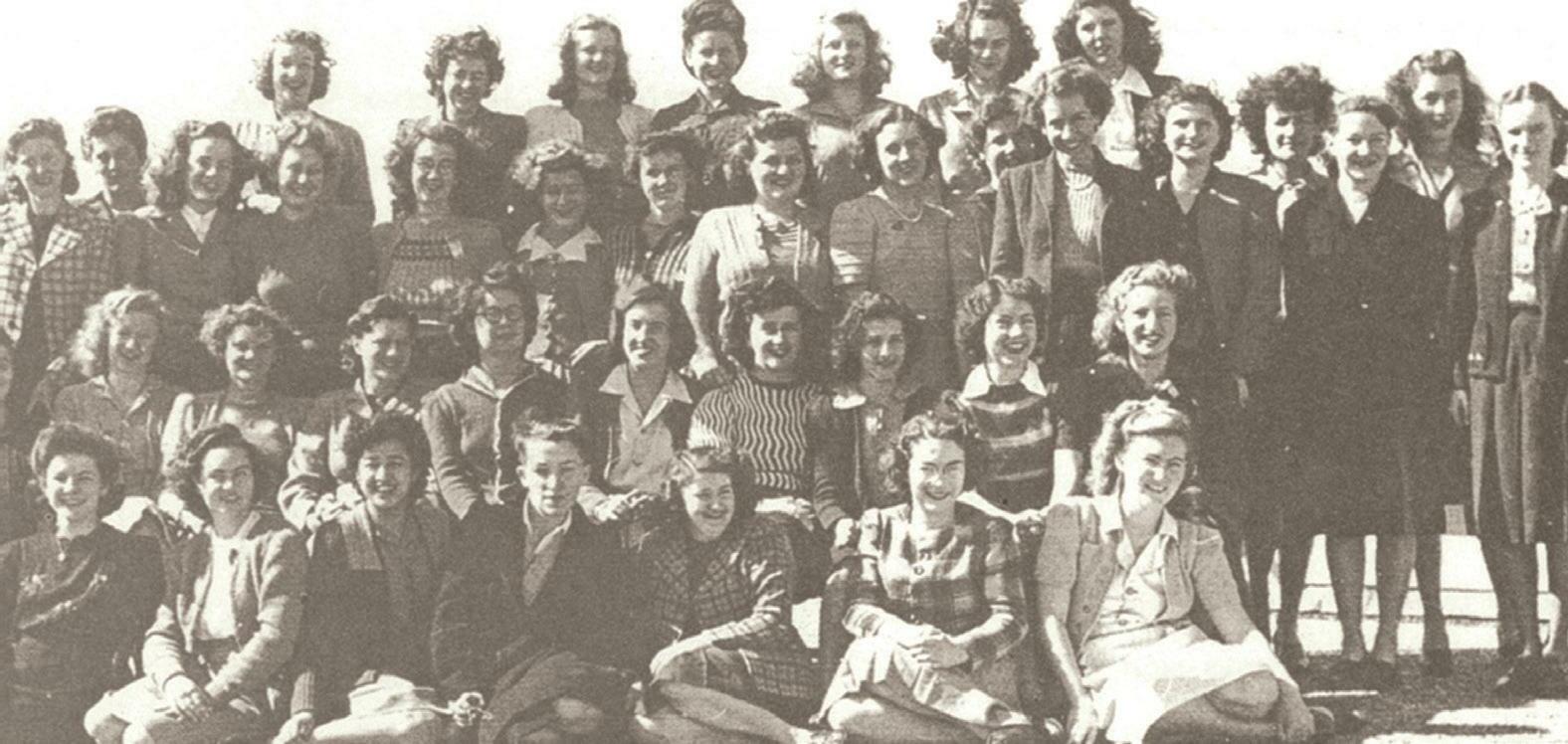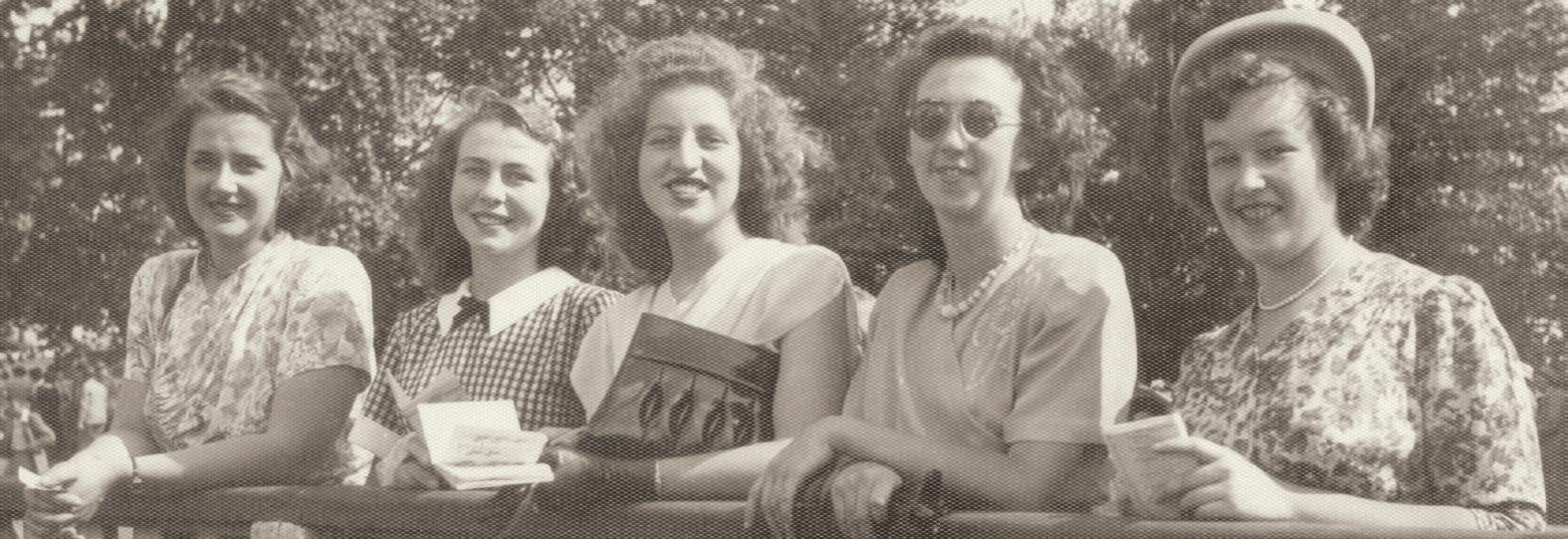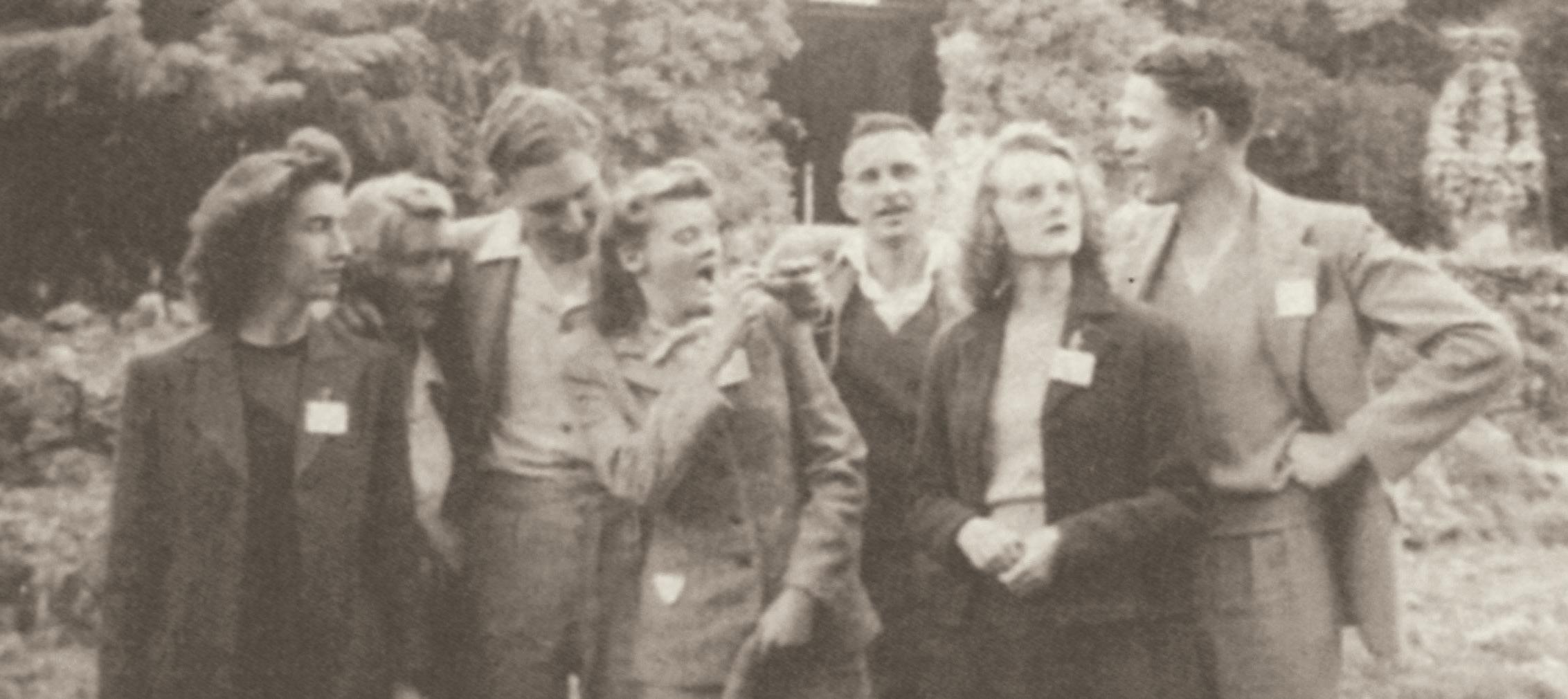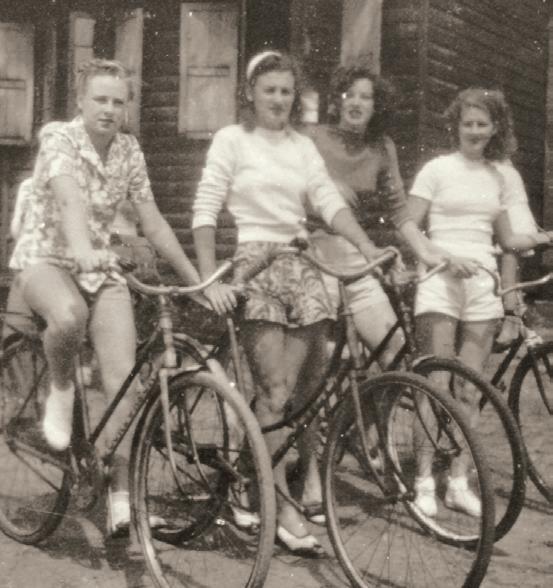
18 minute read
The 1940’s
Staff lunch break
CHAPTER FOUR
Advertisement
THE 1940’S
YEARS OF WAR AND REBUILDING
It was not until 1942, that the firm began to feel the full impact of the war but even in 1940 times were difficult. At the directors’ meeting held on the 10th October 1940 it was reported that six men had enlisted and reference was made to the great problems of obtaining suitable new men to train in the job. The names of five of those six, and the dates they enlisted, are available.
Charlie Cowden November 1939 Steve O’Loughlin Early 1940 Hugh Ferrier April 1940 Syd Wedderburn June 1940 Noel Miller July 1940
Right though the war E.R. Woolcott had to balance the national interests against those of the firm. At times he tried to dissuade men from joining up or endeavoured to have them manpowered to the firm or just hoped they might be exempt from service on medical grounds. The manpower regulations in force acknowledged that not everyone could be in the services; some had to stay home to run the country, so to speak. Noel Miller as a 29 year old was keen to enlist but the old man suggested he wait and see if things got really serious. Noel thought the fall of France in June 1940 was serious enough for him and he joined the army in July.
In 1941 the war in Europe was becoming more serious and was a dark cloud on the horizon which could not be ignored. Nevertheless the firm had to carry on its business and try to plan for the future. Cyril Bird in his report of 8th August, 1941, accompanying the 1940/41 accounts, referred to increasing tax rates and it being essential for business people to get advice on the preparation of tax returns - a situation presenting opportunities for the firm if it were able to take advantage of it.
Don Scott transferred from Katanning to Perth Office in February, 1941 to assist with the management and administration. There was one enlistment - Frank Fowles joined up in October. On the 24th November 1941 Cyril Bird was elected a director of the company and appointed manager of the firm and Len Newman was appointed assistant manager, although they had occupied these positions for some years but with the titles “Secretary” and “Assistant Secretary”.
On the same day E.R. Woolcott (always putting forward new ideas) said he was contemplating bigger things when the war was over and had in mind an idea to assist Western Australia to repatriate the returned soldiers which would be a work of unusual public benefit and would bring the company’s name much into prominence. Within a fortnight any immediate plans for post-War activity had to be thrust aside as the Japanese launched their attack on Pearl Harbour on 7th December.
The next two years, 1942 and 1943, were probably the most difficult the firm has ever faced; more difficult than the depths of the Depression ten years earlier. Singapore fell to the Japanese in February 1942 and in the same month Darwin was bombed. Suddenly the war was very close to home. Every able-bodied man enlisted and the firm was left with just nine senior accountants who had been rejected for military service for one reason or another. Seven men had enlisted from 1939 to 1941 but following the fall of Singapore another fourteen joined up (nine in the months of February and March, 1942). Those who enlisted at that time were: Cliff Beverstock Des Christian Geoff Green Denis Hawcroft Roy Henderson Ernie Jensen Bill Keene Ron Moore Don Scott Jack Skipsey Raynor Stevens Jack Temby Arthur Turner Geoff Whitehead
Endeavours were made to plug the gaps by recruiting some older men; Neil van Noort (53) in June, 1940, Alex Graham (48) in July, 1941, Andy Andrewartha (56) in October, 1942 and Bill Bennett (53) in November, 1942 but there were insufficient of them and finally, in 1943, the work of 500 clients had to be relinquished. This was done with great reluctance and came back to haunt the firm many times in the early post war era as it created an impression that the firm did not want new business and also caused a good deal of resentment among the 500 clients and their connections.
Two other important measures were adopted in those years. One was known as the “pick up system”.
Support staff September 1946
It was implemented in October 1942 and involved a team of men going around the country picking up cheque butts, bank statements and other papers, going through the papers with the client to ensure as far as possible that all was in order and bringing everything back to Perth for processing by a team of female clerks supervised by accountants. The other measure was the withdrawal of the resident accountants from a number of country centres. In 1940 resident representatives had been appointed to Albany, Collie and Moora bringing to eleven the country practices serviced in this way. Seven of these were closed in the next three years, being;
Gnowangerup 1940 Mount Barker 1940 Goomalling 1942 Albany 1942 Moora 1942 Katanning 1943 Collie 1943
The only towns at which the firm maintained representation throughout the war years were Bunbury, Kalgoorlie, Bridgetown and Geraldton. Bridgetown was regarded as a prestigious practice which should have a resident accountant and when Raynor Stevens enlisted in January 1943 Dick Turner was transferred over from Katanning to keep the practice going and Katanning was serviced from Perth until May 1947.
Following the raids on Darwin and Western Australian towns in 1942 the directors became worried that a bomb might land on the AMP Chambers and destroy the records. It was decided to relocate all internal records, client files, stationery and most of the staff away from the central city area and the Kalamunda Hotel was leased for this purpose. Some space and a skeleton staff were retained in the AMP as a convenience for clients and also as a base for the city accountants but everything else went to Kalamunda in the winter of 1942.
One matter not connected with the war and of considerable interest to the staff of the day was the re-establishment of the bonus scheme. The 1930 scheme lapsed after the second distribution of shares in 1931 because of the Depression but at the directors’ meeting on 27th September 1943 employees with a minimum of nine years’ service were issued with ordinary shares in the company. Those participating were Messrs Bird, Fletcher, Groom, Leaney, Newman and Parker.
A sad event at the beginning of 1944 was the death of Ted Fletcher on 18th January who had done so much to expand the interests of the firm in his ten years of service.
As 1944 became 1945 all could see the War was close to an end and thoughts started to turn to post war rebuilding. Syd Wedderburn had been released from the services in April 1943 (possibly on medical grounds) and Geoff Whitehead and Bill Keene in November 1944. By September 1945 the services were releasing men for periods of time to return to the firm and assist with the work. Later that year full demobilisation started and a further thirteen men returned in late 1945/early 1946.
The sudden influx of returned servicemen required almost as much planning and re-organisation as their sudden departure in 1942. The first move was to get the country centres manned again. In 1945 Collie, Gnowangerup and Moora were re-opened. In 1946 Albany was re-opened and three new centres were established - Kellerberrin, Narrogin and Waroona.
Those early post-war years were difficult in terms of trying to rebuild the practice and recruit staff of the right calibre but at the same time they were exciting years because everything was in short supply including accounting services. The firm could sell everything it could produce or in other words there were clients ready to buy whatever quality accounting services the firm could deliver.
Staff recruitment was a top priority. Efforts locally were not producing sufficient results so advertisements were placed in Eastern States newspapers and Cyril Bird made a recruitment trip in 1946 to interview applicants. Four of the men engaged at that time gave the firm long service and all became partners. They were Keith Fry (39 years service) Bert Wright (38 years) Cliff Ellis (35 years) and Harry Spilsbury (34 years).
A three year plan of reconstruction and development was adopted starting from 1st July 1946. In the minutes of 28th August 1947 Cyril Bird reported that the firm had made a decision to take advantage of the inevitable business boom rather than move along cautiously and 15 new men had been brought in for training as accountants and the returned servicemen re-trained at the same time. The heavy
expenditure incurred on this exercise resulted in a substantial loss for 1946/47 -much higher than the forecast figure of £2,000 - and no dividend was declared on either preference or ordinary shares.
In other respects though the plan was working. Extra organisers had been engaged and over the year new clients had been signed up at the rate of thirty per week.
The benefits of this activity began to flow the next year and a profit was earned in 1947/48 which enabled a 10% dividend to be paid on preference shares but a dividend for the ordinary shareholders was still withheld. The next year, 1948/49, saw better than expected profits and all shareholders received a dividend.
The firm was watching expenses closely in those post-war reconstruction years. The Australian Taxation Office wrote on 25th March 1947 criticising the typing of accounts and statements on both sides of the paper and requesting that this war time austerity measure be discontinued. Cyril Bird replied saying the paper position was worse than during the war years but to assist the Taxation Department with its filing where anything was typed on the back of a sheet it would be done upside down (top to toe).
There was a change in the directorate. J.A. Coleman the hotelier from Victoria Park who was a foundation director in 1930 did not nominate when he came up for re-election on 27th September 1946. It was decided not to seek a replacement until the directors had more time to plan the future. New activities and new capital would probably be part of the plan and it might benefit the company to offer a seat on the Board to some influential person.
The recruiting in the years from 1946 to 1949 produced sixteen persons who stayed with the firm in excess of 25 years and ten of these became partners.
This was an ever better result than that achieved in the post-Depression recruitment activities of ten years earlier, 1934 to 1938, when nine went on to complete 25 years service.
Those early post-War years set the scene for 20 years of sustained growth and expansion in Western Australia. The firm could have just drifted from a war-time operation to a peace-time operation allowing itself to be carried along by the course of events and making a modest profit but a post-War plan was adopted and aggressively followed. Accountants were recruited in the expectation that growth would be achieved and new clients would need to be serviced. This resulted in financial losses for a year or so but that was the cost of the post-War expansion plan.
The firm’s market in those years was medium to small business in the city and in the country. The number of accountants servicing city clients was increased and a degree of regionalisation introduced in that clients in a particular area were allocated to an accountant who lived in that area to minimise travelling as the bulk of the work was still done at the client’s place of business in accordance with the firm’s principle of taking the service to the client.
There was also rapid expansion in the country. From the end of the war to the end of 1949 five country branches were re-opened and 12 new ones set up. One was closed – Collie in 1948. The openings and re-openings of that period were:
On 12th March 1948 the company changed its status to a proprietary company by amending the Articles to incorporate the necessary restrictions on number of members, invitations to the public, etc. and changed its name to The National Service Company Proprietary Limited.
The end of decade is, of course, only an arbitrary point, as indeed is the end of a financial year, but to review events it is necessary to close off at some date and the end of the 1940’s seems a logical point to conclude an examination of early post-war activity, although the rapid growth of the late 1940’s continued unabated into the 1950’s and beyond.
Re-opened
1945 Gnowangerup, Collie, Moora
1946 Albany
1947 Katanning
Opened
1946 Kellerberrin, Narrogin, Waroona
1947
1948 Beverley, Margaret River, Wongan Hills
Donnybrook, Dowerin, Manjimup, Northam, Three Springs
1949 Corrigin
COUNTRY HOUSING
When the War finished and post-War expansion plans were put into operation, it became apparent that housing would have to be provided in the country towns. It was not reasonable to expect the accountant to buy or build a house in a small country town. He might be there for only two or three years and with such a small market there could well be difficulties in selling the house when he moved on.
The first house purchased by the firm was in Moora in 1946 for Ernie Jensen and his wife. The cost was £812.3.0 ($1,624.30). By 30th June, 1952 houses had been acquired at Waroona, Bruce Rock and Narrogin and in 1953 at Kalgoorlie bringing the total to five. The expansion of the 1950’s and 1960’s brought with it an even greater need for housing and by 30th June, 1967 the firm owned forty houses in the country and had an interest in another fourteen units of real estate being vacant land held for future housing, deposits paid on land or houses and houses in course of erection.
Most houses acquired were built by the firm, not purchased already erected, and these began to develop a distinctive style, so that it was possible in driving around a Western Australian town to instantly recognise a “Birds” home. The basic plan provided for a front porch or patio on to which two doors opened, one to the office and one to the hallway or living room of the house. These were after the style of a doctor’s house/surgery of earlier days.
Providing so many houses became a big drain on capital and in 1968 the Executive Committee adopted a policy of seeking out client/investors to build the houses.
A number of farmer clients were pleased to co-operate as it provided them with an off-farm asset and as the firm entered into a lease agreement and undertook maintenance the property was generally worry-free for the owner.
Further policies adopted to preserve capital were to try to rent suitable houses rather than buy and to require accountants going to larger coastal towns to provide their own houses.
As the firm began to withdraw representatives from the smaller country towns in the 1970’s and service the clients from the larger regional centres, the houses in many smaller towns were sold and from a peak of forty houses in 1967 the current number is sixteen.
WORKING IN KALAMUNDA
Although the firm operated from Kalamunda for probably no more than six or seven months, the experience remained fresh in memories for many years after. Each morning the staff caught the bus at the AMP corner and travelled up to Kalamunda. Recollections are of a happy time working in the hills and of it being very cold which made a hot lunch the highlight of the day.
During the time the firm was there, the added volume of mail resulted in the Postmaster General advancing the Kalamunda Post Office in grade which gave an entitlement to increased staff.
Gwen Thomas worked out the pays in Perth on Friday morning and was driven up to the hills by an accountant during the afternoon to pay the staff. The cash was counted at a table on which was spread a large cloth so that if there was an air raid she could quickly gather up the four corners of the cloth and run from the AMP to a nearby air raid shelter with the bundle of money clasped to her person.
An incident often recalled by those who worked in Kalamunda concerns some client files which, because of lack of storage space, were stacked neatly on the floor in the corner of a room. There was no call to refer to the files for some months but finally when one of the files was required there was great consternation when it was discovered that white ants had eaten out the whole centre of the stack and all that was left was a shell.
By the end of 1942 the likelihood of Perth being bombed had receded and this, combined with the inconvenience of operating from two offices, led the directors to vacate the Kalamunda Hotel and move the staff back to the AMP Chambers.
At the races 1946

Staff Picnic Yanchep about 1947

From Left: Fay Whittome (later Mrs Keith Fry), Paula Acton, Allan Holywell, Pam Nelthorpe (later Mrs Allan Holywell), Alan Huxtable, Vi Meacham, Bill Lapsley.
SPECIAL SERVICES
In the early days the term “special services” would have meant all services not being basic compliance work such as writing up books and preparing financial statements and income tax returns. Many matters which would have been “special” in the 1920’s and 1930’s, today are merely “standard”. Those early special services offered by the firm progressively evolved into complex services directed towards tax planning, estate planning, corporate finances, business services and a host of other matters.
A booklet issued in 1942 to commemorate the 20th Anniversary of the firm devotes space to the activities of an already well-established “Service Department” and refers to the statistical and research sections of that department and its work of “preparing reports and answering the inquiries sent in by clients”.
A sample list of referrals by clients is featured in the booklet and includes timeless ones like an efficient stock control system, advice on proposed expansion, obtaining extra capital and whether to rent or buy premises but also includes two referrals by primary producers which make interesting reading fifty years on:
“Shall I buy a tractor and do away with my horses?”
“Will it pay me to put in milking machines?”
In 1962 the firm issued its first “Organisation Chart” showing the divisions into which the firm was divided and one of these was called “Consultative” with Bob Klein the partner-in-charge. The functions of the division came to be known later as “Management Consulting Services”.
The MCS Division provided a valuable range of services for many years. When Bob Klein retired in December 1986 Brian Mellor took over as partner-in-charge.
In 1989 there was a re-organisation of Management Consulting Services and a division called “Corporate Financial Services” set up on a national basis with Colin Blyth the chairman of the relevant committee. Also, each State office created a section offering “Business Services” to complement corporate financial services.
The other major service which had its beginnings in the early days of the firm was tax planning which grew to embrace estate planning. Not long after the end of the War, Charlie Cowden pioneered the Tax & Estate Planning division. In January, 1952 Neville Harris transferred to Perth office as his assistant and remained in that role until 1966. Meanwhile Bill Caldow had come into the division in 1959 and took over as Executive partner-in-charge in September, 1973 when Charlie Cowden retired and continued in the position until he retired in December, 1989.
In the re-organisation of the early 1990’s “Taxation Services” became a national technical activity with Rodger Gibson chairman of the relevant committee.
1940 Five men enlisted in the services.
1941 One man enlisted in the services. Cyril Bird elected director of the company and appointed manager. Len Newman appointed assistant manager.
1942 Singapore fell and Darwin bombed February. Fourteen men enlisted in the services. “Pick up system” implemented to handle accounting work for clients. Most of Perth office staff relocated in Kalamunda.
1943 Work of 500 clients relinquished.
1944 Ted Fletcher died 18th January.
1945 End of War. Demobilisation and most men rejoined late 1945/ early 1946.
1946 Cyril Bird made interstate recruitment trip. Three year plan of reconstruction and development adopted from 1st July. Tax and Estate Planning Division commenced under Charlie Cowden. Firm expanded to a second floor of AMP Chambers. Agency with WA Trustee Company terminated. Director J.A. Coleman did not re-nominate. Bill Lapsley commenced 7 October. First country residence acquired, Moora for Ernie Jensen. Cost £812.3.0.
1948 Company converted to a proprietary company on 12th March. Mrs Jessie Woolcott retired from full-time duties.
Year Name Retired Completed Years
1940 Laurie Harrison
1940 Neil van Noort
1941 Geoff Green 1970 29
1962 21
1971 30
1944 Jean Bennett 1967 23
1944 Dorothy Evans (nee Hookway) 1967 20
1946 Bill Lapsley
1946 Keith Fry
1946 Bert Wright
1946 Cliff Ellis 1987 40
1986 39
1984 38
1981 34
1946 Ted Foley
1946 Frank Ford
1946 Alan Huxtable 1979 33
1978 32
1979 32
1946 Aub Evans
1946 Bob van Noort
1947 Bob Klein
1947 Harry Spilsbury
1948 Alan Hicks 1978 31
1972 26
1986 39
1981 34
1988 40
1948 Val Sales
1949 Neville Harris
1949 Alan Smith 1984 25
1989 40
1985 36
1949 Nobby Clark
1949 Bob Dickson 1977 · 28
1977 28

Bickley Weekend Basketball Team 1947












